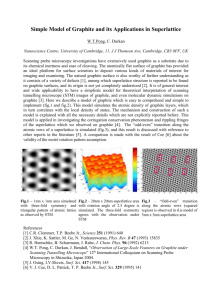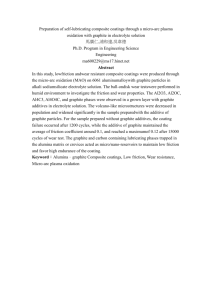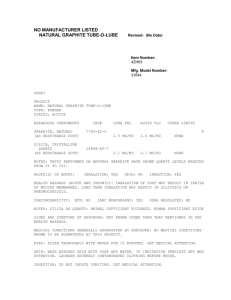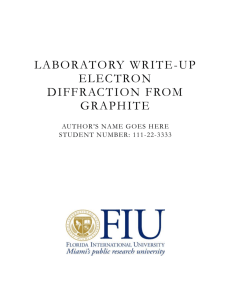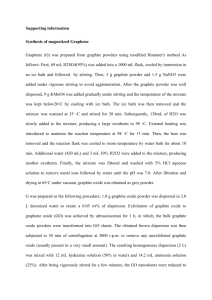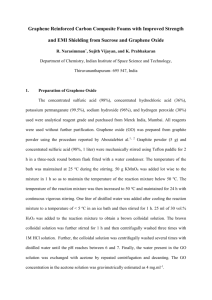Supplementary Information - Springer Static Content Server
advertisement
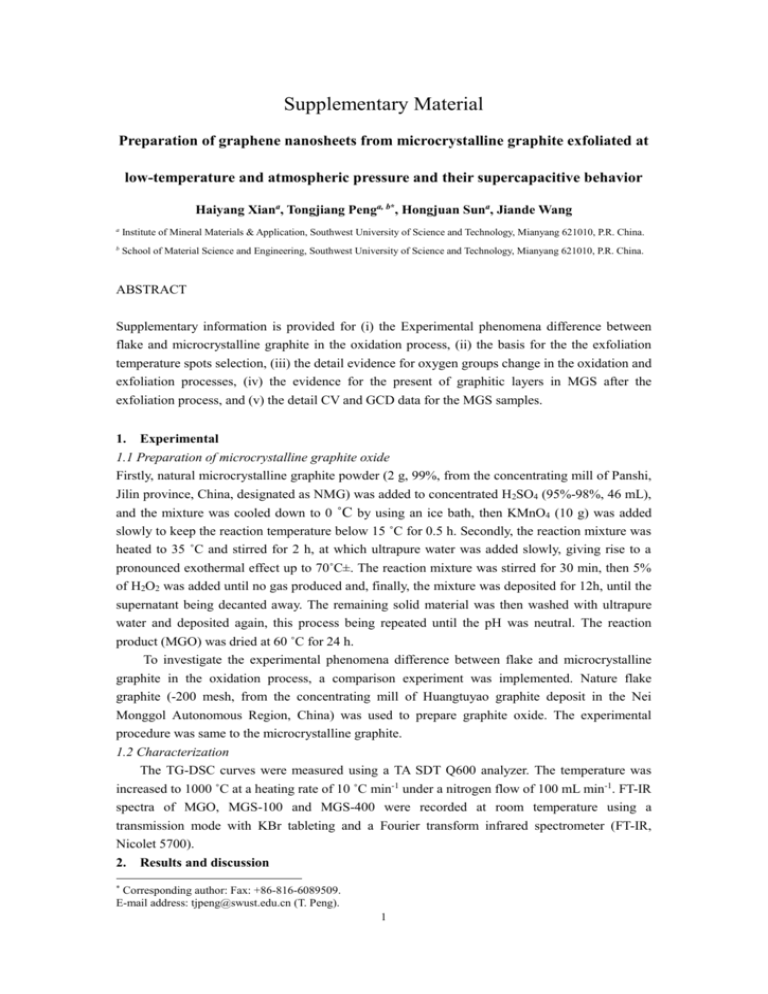
Supplementary Material Preparation of graphene nanosheets from microcrystalline graphite exfoliated at low-temperature and atmospheric pressure and their supercapacitive behavior Haiyang Xiana, Tongjiang Penga, b*, Hongjuan Suna, Jiande Wang a Institute of Mineral Materials & Application, Southwest University of Science and Technology, Mianyang 621010, P.R. China. b School of Material Science and Engineering, Southwest University of Science and Technology, Mianyang 621010, P.R. China. ABSTRACT Supplementary information is provided for (i) the Experimental phenomena difference between flake and microcrystalline graphite in the oxidation process, (ii) the basis for the the exfoliation temperature spots selection, (iii) the detail evidence for oxygen groups change in the oxidation and exfoliation processes, (iv) the evidence for the present of graphitic layers in MGS after the exfoliation process, and (v) the detail CV and GCD data for the MGS samples. 1. Experimental 1.1 Preparation of microcrystalline graphite oxide Firstly, natural microcrystalline graphite powder (2 g, 99%, from the concentrating mill of Panshi, Jilin province, China, designated as NMG) was added to concentrated H2SO4 (95%-98%, 46 mL), and the mixture was cooled down to 0 ˚C by using an ice bath, then KMnO4 (10 g) was added slowly to keep the reaction temperature below 15 ˚C for 0.5 h. Secondly, the reaction mixture was heated to 35 ˚C and stirred for 2 h, at which ultrapure water was added slowly, giving rise to a pronounced exothermal effect up to 70˚C±. The reaction mixture was stirred for 30 min, then 5% of H2O2 was added until no gas produced and, finally, the mixture was deposited for 12h, until the supernatant being decanted away. The remaining solid material was then washed with ultrapure water and deposited again, this process being repeated until the pH was neutral. The reaction product (MGO) was dried at 60 ˚C for 24 h. To investigate the experimental phenomena difference between flake and microcrystalline graphite in the oxidation process, a comparison experiment was implemented. Nature flake graphite (-200 mesh, from the concentrating mill of Huangtuyao graphite deposit in the Nei Monggol Autonomous Region, China) was used to prepare graphite oxide. The experimental procedure was same to the microcrystalline graphite. 1.2 Characterization The TG-DSC curves were measured using a TA SDT Q600 analyzer. The temperature was increased to 1000 ˚C at a heating rate of 10 ˚C min-1 under a nitrogen flow of 100 mL min-1. FT-IR spectra of MGO, MGS-100 and MGS-400 were recorded at room temperature using a transmission mode with KBr tableting and a Fourier transform infrared spectrometer (FT-IR, Nicolet 5700). 2. Results and discussion * Corresponding author: Fax: +86-816-6089509. E-mail address: tjpeng@swust.edu.cn (T. Peng). 1 Fig. S1 shows the experimental phenomena difference between flake and microcrystalline graphite in the oxidation process. On one hand, it can be seen that the graphite oxide from flake graphite displays golden yellow, after 12h sedimentation, the supernate is clear while the bottom displays gradual change from golden yellow to dark black, indicating that the graphite is colloidal. In this case, graphite oxide film can be obtained after drying. On the other hand, the experimental phenomena of the microcrystalline graphite is obvious different from the former, the graphite oxide from microcrystalline graphite displays dark olivine, after 12h sedimentation, all the graphite oxide become the sediment in the bottom of the beaker. In this case, it cannot form graphite oxide file, but a heap of graphite powder. Fig. S1–Experimental phenomena difference between flake and microcrystalline graphite in the oxidation process. Fig. S2 shows the TG-DSC curves of MGO. A sharp endothermic peak at 213 ˚C can be found easily in this figure. The exfoliation temperature spots in this work were chosen according to the endothermic peak. 2 28 213 C 26 100 24 22 20 Weight / % 16 14 12 10 60 8 6 4 Heat flow / (mW/mg) 18 80 2 40 0 -2 -4 20 200 400 600 800 -6 1000 Temperature / C Fig. S2–TG-DSC curves of MGO. Fig. S3 shows the TEM images of MGS-100 with graphitic layers. The lattice fringe can be seen in the figure clearly, indicating that there still graphitic layers inMGS-100. Fig. S3–TEM images of MGS-100 with graphitic layers, the insert is the SAED pattern of the corresponding area. 3 C1s O(KLL) O1s MGS-400 MGS-100 MGO 1000 800 600 400 200 0 Binding Energy (eV) Fig. S4–XPS survey spectra of MGO, MGS-100 and MGS-400. Fig. S5 shows the FT-IR spectra of MGO, MGS-100 and MGS-400. The relatively broad peak at 3415 cm-1 and relatively sharp peak at 1627 cm-1 indicate that the samples contain adsorbed water. The peaks at 1739 cm-1, 1400 cm-1 and 1220 cm-1 can be assigned to the carbonyl, hydroxyl and epoxy groups in the structure of MGO. Compared with the pristine MGO, the intensities of the peaks at 1400 cm-1 and1220 cm-1 for MGS-100, which indicates that the functional groups on the surface of the MGO layers decomposes partially. The disappearance of the peaks at 1739 cm−1, 1400 cm−1, and 1220cm−1 for MGS-400 indicates that the functional groups have been almost removed. LTEG-400 LTEG-100 AGO 4000 3500 3000 2500 2000 1500 Wavenumbers / cm 1000 500 -1 Fig. S5–FT-IR spectra of MGO, MGS-100 and MGS-400. 4 6 4 MGS-100 (a) 5 -1 0 Current / A g -1 2 Current / A g MGS-400 (b) 10 -1 -2 5 mV s -1 10 mV s -1 20 mV s -1 30 mV s -1 50 mV s -4 -6 -8 -0.8 -0.6 -0.4 -0.2 0.0 0 -1 -5 5 mV s -1 10 mV s -1 20 mV s -1 30 mV s -1 50 mV s -10 -15 -20 -0.8 0.2 -0.6 -0.4 -0.2 0.0 0.2 Potential / V (vs Hg/HgO) Potential / V (vs Hg/HgO) Fig. S6–Cyclic voltammograms for MGS-100 (a) and MGS-400 (b) at different scan rates from 5 to 50mV s−1. 0.2 (a) (b) MGS-100 MGS-400 0.0 Potential(V vs Hg/HgO) Potential(V vs Hg/HgO) 0.2 -1 0.5 A g -1 1.0 A g -1 2.0 A g -1 3.0 A g -1 5.0 A g -0.2 -0.4 -0.6 0.0 -1 0.5 A g -1 1.0 A g -1 2.0 A g -1 3.0 A g -1 5.0 A g -0.2 -0.4 -0.6 -0.8 -0.8 0 50 100 150 200 250 300 350 0 400 100 200 300 400 500 600 t (s) t (s) Fig. S7–GCD curves for MGS-100 (a) and MGS-400 (b) at different current density from 0.5 to 5.0 A g−1. 5 700

